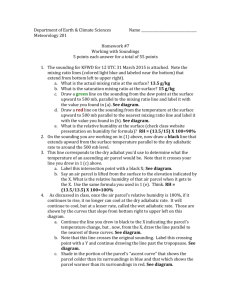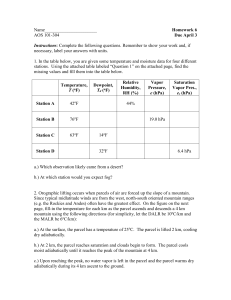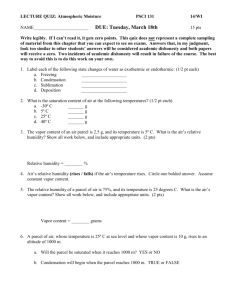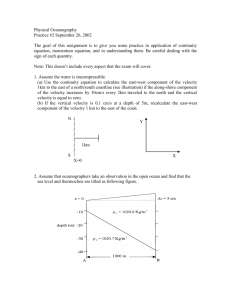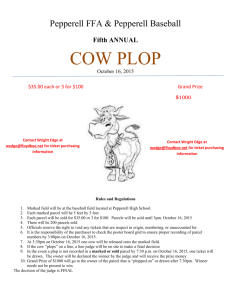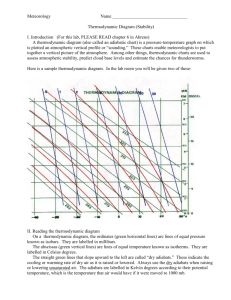Word
advertisement
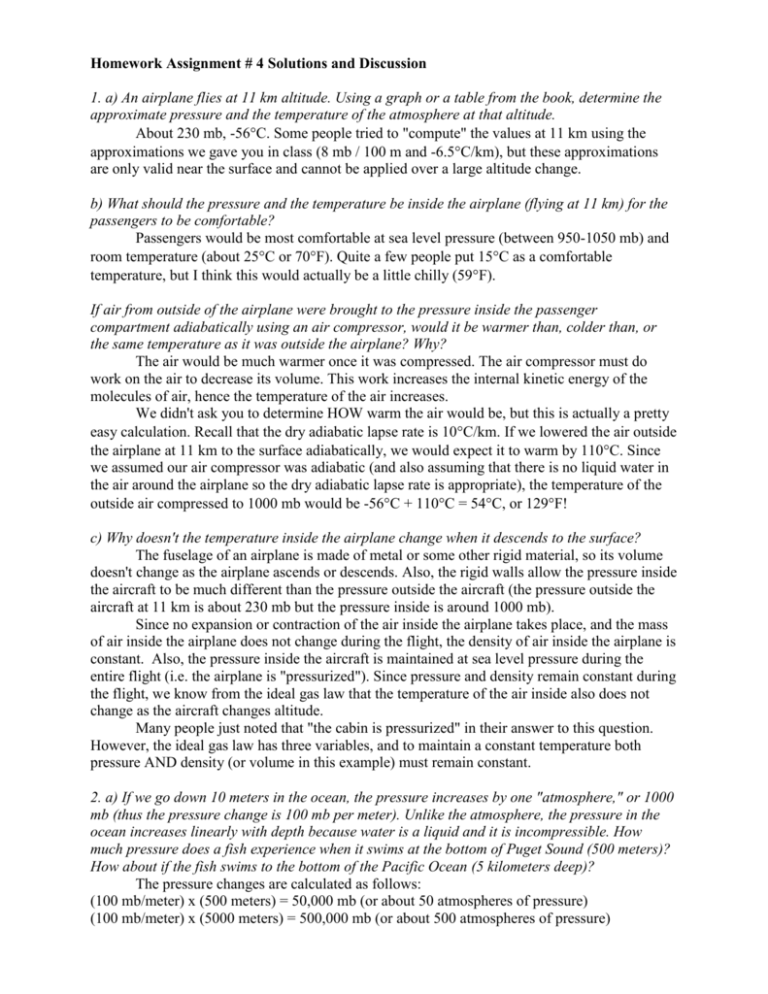
Homework Assignment # 4 Solutions and Discussion 1. a) An airplane flies at 11 km altitude. Using a graph or a table from the book, determine the approximate pressure and the temperature of the atmosphere at that altitude. About 230 mb, -56C. Some people tried to "compute" the values at 11 km using the approximations we gave you in class (8 mb / 100 m and -6.5C/km), but these approximations are only valid near the surface and cannot be applied over a large altitude change. b) What should the pressure and the temperature be inside the airplane (flying at 11 km) for the passengers to be comfortable? Passengers would be most comfortable at sea level pressure (between 950-1050 mb) and room temperature (about 25C or 70F). Quite a few people put 15C as a comfortable temperature, but I think this would actually be a little chilly (59F). If air from outside of the airplane were brought to the pressure inside the passenger compartment adiabatically using an air compressor, would it be warmer than, colder than, or the same temperature as it was outside the airplane? Why? The air would be much warmer once it was compressed. The air compressor must do work on the air to decrease its volume. This work increases the internal kinetic energy of the molecules of air, hence the temperature of the air increases. We didn't ask you to determine HOW warm the air would be, but this is actually a pretty easy calculation. Recall that the dry adiabatic lapse rate is 10C/km. If we lowered the air outside the airplane at 11 km to the surface adiabatically, we would expect it to warm by 110C. Since we assumed our air compressor was adiabatic (and also assuming that there is no liquid water in the air around the airplane so the dry adiabatic lapse rate is appropriate), the temperature of the outside air compressed to 1000 mb would be -56C + 110C = 54C, or 129F! c) Why doesn't the temperature inside the airplane change when it descends to the surface? The fuselage of an airplane is made of metal or some other rigid material, so its volume doesn't change as the airplane ascends or descends. Also, the rigid walls allow the pressure inside the aircraft to be much different than the pressure outside the aircraft (the pressure outside the aircraft at 11 km is about 230 mb but the pressure inside is around 1000 mb). Since no expansion or contraction of the air inside the airplane takes place, and the mass of air inside the airplane does not change during the flight, the density of air inside the airplane is constant. Also, the pressure inside the aircraft is maintained at sea level pressure during the entire flight (i.e. the airplane is "pressurized"). Since pressure and density remain constant during the flight, we know from the ideal gas law that the temperature of the air inside also does not change as the aircraft changes altitude. Many people just noted that "the cabin is pressurized" in their answer to this question. However, the ideal gas law has three variables, and to maintain a constant temperature both pressure AND density (or volume in this example) must remain constant. 2. a) If we go down 10 meters in the ocean, the pressure increases by one "atmosphere," or 1000 mb (thus the pressure change is 100 mb per meter). Unlike the atmosphere, the pressure in the ocean increases linearly with depth because water is a liquid and it is incompressible. How much pressure does a fish experience when it swims at the bottom of Puget Sound (500 meters)? How about if the fish swims to the bottom of the Pacific Ocean (5 kilometers deep)? The pressure changes are calculated as follows: (100 mb/meter) x (500 meters) = 50,000 mb (or about 50 atmospheres of pressure) (100 mb/meter) x (5000 meters) = 500,000 mb (or about 500 atmospheres of pressure) Where one "atmosphere" of pressure is 1000 mb. But don't forget that at the surface of the ocean, the fish would still feel the pressure of the atmosphere above, so we must start at sea level pressure, which is about 1013 mb (we will round to 1000 mb here). Thus the pressure experienced by the fish at the bottom of Puget Sounds is about 50,000 mb + 1000 mb = 51,000 mb (or about 51 atmospheres), while the pressure experienced by the fish at the bottom of the Pacific Ocean is about 501,000 mb (about 501 atmospheres). b) If we took a "parcel" of water at the surface of the Pacific Ocean and lowered it down to a depth of 5 kilometers, would it be warmer, colder, or the same temperature that it was at the surface? Why? (Assume that the parcel does not mix with the surrounding water.) Unlike air, water is not compressible (you cannot "shrink" the amount of water in a glass, no matter how hard you push down on it). Although a parcel of water lowered down to 5 kilometers depth will feel approximately 501 atmospheres of pressure, its volume cannot change. Since the parcel of water does not expand or contract, and we assumed that the parcel did not "mix" with any of the surrounding water, it will remain at the same temperature that it was at the surface (at least, until it radiates away this energy). Note that the water in the deep ocean is actually very cold (typically 0-4C). Most of the sun's radiation is absorbed in the first few meters of the ocean, so that below 50 meters or so, the ocean is very cold almost everywhere on the globe. 3. Initially, a parcel of air is at the surface and it has a water vapor mixing ratio of 13 g/kg and a temperature of 28C. The saturation mixing ratio for air at this temperature is about 24 g/kg. The parcel begins to rise through the atmosphere, cooling at the dry adiabatic lapse rate (-10 C/km) because it is not saturated. Since the parcel cools as it rises, the saturation mixing ratio will decrease as the parcel ascends (the parcel can hold less water vapor as it gets colder). As soon as the saturation mixing ratio equals the mixing ratio of the air in the parcel, water vapor will condense and the parcel will cool at the moist (wet) adiabatic lapse rate (about -4C/km) as it rises further. (As in class, we will assume that any water vapor that condenses in this manner immediately precipitates out of the parcel and falls to the ground below.) a) Complete the table below, in which you are given the initial temperature and mixing ratio of the parcel and the saturation mixing ratio for the parcel at each level as it rises and then sinks (note that this table describes the parcel, not the surrounding environmental air). saturation mixing ratio (g/kg) mixing ratio (g/kg) temperature (C) relative humidity (%) 0 km 24 10 28 42 1 km 15 10 18 67 2 km 10 10 8 100 rises 3 km 7 7 4 100 2 km 13 7 14 54 1 km 22 7 24 32 0 km 34 7 34 21 sinks The parcel initially is not saturated (RH=42%), so it will rise dry adiabatically to 2 km and during this ascent it will expand and cool at the dry adiabatic lapse rate of -10C/km. So at an altitude of 2 km it will have cooled to a temperature of 8C. The mixing ratio will remain at the same value during this ascent (10 g/kg) because we have not added or subtracted any water vapor from the parcel. Note that at this temperature (8C), the saturation mixing ratio has dropped to 10 g/kg so the parcel is holding the maximum possible amount of water vapor that it can hold at this temperature--it is saturated and its relative humidity is 100%. As it rises further to 3 km, the parcel will cool at the moist adiabatic lapse rate (because it is now saturated), which we told you is about -4C/km. The saturation mixing ratio will decrease below 10 g/kg since the parcel is cooling, and the "extra" water vapor in the parcel must condense to form liquid water until the water vapor mixing ratio equals the saturation mixing ratio. Recall that condensation releases latent heat. This latent heat release is the reason why the moist adiabatic lapse rate is only -4C/km instead of -10C/km; the "extra" 6C/km comes from latent heating. We assume that all of the condensed liquid water immediately precipitates out of the parcel as rain. When the parcel reaches 3 km, it will have cooled to 4C, and since it remains saturated as it rises, we know that the mixing ratio of the parcel will be equal to the saturation mixing ratio of 7 g/kg at this altitude. Note that 3 g/kg of water vapor has condensed to form liquid water and rained out of the parcel (this will be useful for part e). Now the parcel starts to sink. The atmospheric pressure exerted on the parcel increases as it sinks, so the parcel will contract and warm up. We assumed that all of the condensed water fell out of the parcel as rain, so as soon as the parcel starts to sink from 3 km, it will no longer be saturated and it will warm at the dry adiabatic lapse rate all the way down to the surface. When it reaches the surface the parcel's final temperature will be 34C. The parcel does not gain or lose any water vapor during the descent (we assumed all of the liquid water rained out), so the mixing ratio of the parcel will remain at 7 g/kg all the way down to the surface. Note that the temperature of the parcel at the surface is now warmer (see the next question to find out why), so the saturation mixing ratio is higher when the parcel returns to the surface than it was before it started its journey. So the parcel is now drier and warmer than it was when it started its journey. b) The saturation mixing ratio for the parcel is 10 g/kg at 2 km on the way up, but 13 g/kg at 2 km on the way down. Why are these numbers different? Basically, because the parcel is at different temperatures at 2 km on the way up and at 2 km on the way down. The parcel cools moist adiabatically as it rises from 2 km to 3 km (so its temperature drops 4C), but it warms dry adiabatically as it sinks back down from 3 km to 2 km (and its temperature increases by 10C). Thus the parcel is 6C warmer at 2 km on the way down than it was at 2 km on the way up, and warmer air can hold more water vapor than colder air. c) Explain why the air parcel is at a different temperature than its initial temperature when it returns to the surface. Make sure you mention where the extra energy comes from. As mentioned above, the different temperatures arise because during part of its journey (namely, from 2-3 km) the parcel ascends moist adiabatically but descends dry adiabatically. The extra internal kinetic energy comes from the condensation of water vapor to form liquid water droplets in the parcel--remember that condensation releases latent heat, which is observed as an increase in the average internal kinetic energy (temperature) of the air molecules. Latent heating is the reason why the moist adiabatic lapse rate is not as large as the dry adiabatic lapse rate. Note that this answer depends on our assumption that all of the condensed water immediately rains out of the parcel. If the condensed liquid water were instead suspended in the parcel of air as liquid water droplets, we would have to account for the energy required to reevaporate the liquid water back into water vapor (as in part d). d) If the condensed water vapor did NOT precipitate out of the parcel once it became saturated, what would the mixing ratio of the parcel be when it returns to the surface? What would the temperature be? If the condensed water did not precipitate out of the parcel as it rises from 2 km to 3 km, then our argument in part (a) remains the same up until the point when the parcel starts to sink. If there is liquid water remaining in the parcel as it sinks, the parcel will remain saturated as it sinks, until all the liquid water is re-evaporated into water vapor. Because it is saturated, the parcel in this case cools moist adiabatically during its descent from 3 km to 2 km, because some of the heat added to the parcel due to compression will be used to re-evaporate the liquid water back into water vapor. At 2 km, all of the liquid water has re-evaporated into water vapor, the parcel would be at 8C (just like it was on the way up), and the water vapor mixing ratio would again be 10 g/kg (because we have re-evaporated all of the liquid water that we condensed on the way up). Note that the saturation mixing ratio will be 10 g/kg at 2 km on the way down now, because we have returned to 8C (and the value of the saturation mixing ratio only depends on temperature). The parcel would return to the surface dry adiabatically from 2 km to 0 km, and its temperature would be just the same as it was at the beginning of its journey, 28C. e) If the air parcel initially contained 25 kg of dry air, how much liquid water would fall out of the cloud as precipitation (rain)? (Again, assume all condensed water precipitates during ascent.) We found out in part (a) that 3 grams of water vapor were condensed for every 1 kg of dry air that ascends to 3 km, and we assumed that all of this liquid water immediately falls out of the parcel as rain. If we started with 25 kg of dry air, then since 3 grams of liquid water fall out of the parcel for every kilogram of dry air, the total amount of rainfall would be 75 grams. 4. a) In Seattle in the middle of Winter, a 1 kg parcel of air has a saturation mixing ratio of 12 grams of water vapor per kilogram of dry air. The relative humidity is 90% (it is moist and overcast). Calculate the mixing ratio of the air parcel. RH = mixing ratio / saturation mixing ratio mixing ratio = RH * saturation mixing ratio = 0.90 * (12 g/kg) = 10.8 g/kg b) In Death Valley at the same time of the year, because the temperature is higher, a 1 kg air parcel has a saturation mixing ratio of 38 g/kg. The relative humidity is 40% (dry). Calculate the mixing ratio of the air parcel. mixing ratio = 0.40 * (38 g/kg) = 15.2 g/kg c) Which parcel contains the most water vapor molecules per kilogram of dry air? Was this obvious if we had only considered the relative humidity? Do you think that we "feel" relative humidity or mixing ratio? The Death Valley air, although it has a very low relative humidity, actually contains a greater absolute amount of water vapor per kilogram of dry air, as shown in parts (a) and (b). This is not obvious if we consider only the relative humidity, since it is actually lower in Death Valley. This illustrates the strong temperature dependence of saturation mixing ratio (or saturation vapor pressure, as discussed in the book). We "feel" relative humidity, which is why you often hear this number reported on the evening news. On a moist day, your body will be very sensitive to the level of saturation of the air, rather than to the total amount of water vapor in the air. Note that you could say that the atmosphere "feels" mixing ratio rather than relative humidity, because the amount of water vapor in the air determines the density of the air (and hence buoyancy) and also the amount of water available for precipitation once the air condenses. But the relative humidity determines the level at which condensation will take place. 5) The two graphs above show the vertical temperature structure (sometimes called the "environmental lapse rate") of the first 1000 meters of the atmosphere during a warm summer afternoon (4:00 p.m.) and on the following calm, clear summer night (4:00 a.m.). The 4 p.m. lapse rate it dashed in the 4 a.m. graph for reference. Note that above 200 m, the air temperature has only decreased 5C during the night, but the surface air temperature has dropped 20C, so that a temperature inversion layer is present in the bottom 200 m of the atmosphere at 4 a.m. a) Why does the air near the surface cool more than the air above 200 m during the night? (Hint: recall that air is an excellent insulator--it doesn't conduct heat very well.) Although you were not asked to provide an answer as long as the explanation that follows, we feel that we should be as specific as possible, because there seems to be some confusion about some of the key processes involved in this phenomenon. The Earth's surface is good absorber of both infrared (longwave) and solar (shortwave) radiation (it is essentially a blackbody). The Earth's surface is constantly emitting infrared radiation according to the law ET4, and the surface is also losing energy via conduction, convection, and evaporation. On the other hand, the Earth's surface is constantly receiving infrared energy from the clouds or greenhouse gases in the atmosphere above, and during the day the Earth is also absorbing incoming solar radiation. During the daytime, the Earth's surface absorbs more energy in the form of radiation than it loses via emission, conduction, convection, and evaporation, so it warms up. At night, on the other hand, there is no solar radiation to absorb, so the surface gives off more energy than it receives and thus it cools down. The atmosphere does not absorb solar radiation very well, although the atmosphere does absorb some of the infrared energy emitted from the Earth, which it subsequently re-radiates both up to space and back down to the surface. Note that the temperature of the atmosphere basically depends on the amount of energy it receives from the surface below in the form of infrared radiation, conduction, convection, and evaporation. So during the day, the surface of the Earth is very warm, and the atmosphere very close to the Earth's surface gets warm also via conduction, convection, and mixing by the wind. This layer of very warm air is usually limited to the lowest hundred meters or so of the atmosphere. The atmosphere above this warm layer is too far away from the surface to be warmed much by small-scale convection or conduction (recall that air is an excellent insulator), so the only way that it can warm up is by absorbing longwave radiation from the surface. Recall that the atmosphere typically only absorbs a small amount of this radiant energy (it is not a blackbody), so even though the warmer surface is emitting a lot more radiation during the day, only slightly more radiation is absorbed by the atmosphere above. Thus on a calm summer day the atmosphere near the surface is very warm but the air far above the surface doesn't heat up very much. At night, the surface is no longer receiving solar radiation and it cools rapidly. The layer of air closest to the surface also cools via conduction, but this cooling only extends to a few hundred meters because air is a pretty good insulator and we stated that the night was clear and calm (so no turbulence is around to stir up the air in the lower atmosphere). Above two hundred meters or so, the rest of the atmosphere only "feels" the surface temperature change because the surface is emitting less infrared radiation when it cools down. This means less radiation absorbed by the atmosphere, so their temperature also decreases until they reach radiative equilibrium again. However, because the air is not a blackbody, this temperature change will not be as drastic as it was at the surface. Thus the air in the lowest couple hundred meters will undergo a much larger cooling than the air aloft. Many people only vaguely mentioned the decrease in temperature of the ground by radiational cooling. This alone does not explain the decrease in the temperature of the overlying air, and even less the difference between the air at the surface and the air above 200m. Also note that the air is cooled by conduction of heat from the air to the surface and not the opposite (since the ground is colder). b) Consider a parcel of air at the surface (altitude 0 m, temperature 30C), at 4:00 p.m. If this air parcel were lifted dry adiabatically to 500 m, what would be the temperature of the parcel? The temperature decreases by 10C per kilometer, or 5C per 500m (= half a kilometer). So: T=35C d) What would be the temperature of the environmental air surrounding the parcel at 500 m? Reading on the figure: about 15C e) Recall that cold air is denser than warm air. Comparing the temperature of the parcel to the environmental temperature, do you think the parcel will now rise, remain at 500 m, or sink? The parcel is warmer than its environment; and since the parcel and the environment are at the same pressure at 500 meters, we know that the parcel of air is less dense than the surrounding air at 500 meters, and it will rise. (Again, the reason why we can relate directly temperature and density is that we are comparing the parcel and the surrounding air at the same pressure). f) Repeat questions (b-c-d-e) for a parcel of air pushed up from the surface (10C) at 4:00 a.m. At 500 meters, the parcel would have a temperature of 5C (same calculation as in (b)) but the environment around it would be at 10C (reading the figure). Thus the parcel would be colder and denser than the surrounding air, and it will sink. g) Which situation would you describe as "stable", and which one as "unstable"? The daytime situation is unstable; the nighttime situation is stable. This is why we see more convection (and the associated thunderstorms) during the day than we do at night. 6. If it is 30C and the water vapor pressure is 20 mb, what is the dewpoint temperature? What is the relative humidity of the air? For this problem, use Figure 4.4 (which should be a plot of saturation vapor pressure versus temperature) from the book. The dew point temperature is the temperature at which the water vapor in the air would start to condense if the air was cooled at constant pressure (i.e. the temperature required to bring the air parcel to saturation). The water vapor pressure in the air is given to you: 20 mb. From Figure 4.4 (or 4.5 depending on the edition of your book), the parcel would need to be brought to 17C before condensation starts to take place (at a constant water vapor pressure of 20 mb). Thus the dew point temperature is 17C. The realtive humidity is defined as: RH = water vapor pressure / saturation water vapor pressure The actual water vapor pressure is given to you: 20 mb. The saturation vapor pressure is the vapor pressure at which the air would be saturated, the temperature remaining equal. From Figure 4.4 (or 4.5 depending on your edition), the saturation vapor pressure at 30C is about 42 mb. So: RH= (20 mb / 42 mb) * 100% = 48%



